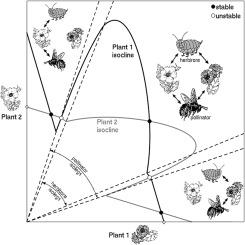Ecological Modelling ( IF 2.6 ) Pub Date : 2021-06-03 , DOI: 10.1016/j.ecolmodel.2021.109634 Tomás A. Revilla , Thomas Marcou , Vlastimil Křivan

|
Two plants can influence one another indirectly by affecting population dynamics of shared exploiters and/or shared mutualists, giving rise to apparent competition or apparent mutualism, respectively. Indirect interactions between plants also occur when the preferences of exploiters and mutualists adapt to changes in relative plant densities. Here we study simultaneous effects of adaptive herbivore and pollinator preferences on the dynamics of two competing plant populations. As a result of feedbacks between plant dynamics and adaptive animal preferences, plants coexist at alternative stable states. This outcome is favored at low abundances of herbivores and pollinators when consumers tend to specialize on a single plant. As herbivore and pollinator abundances increase, generalism becomes more common. This promotes plant coexistence by balancing antagonistic and mutualistic effects between plants. Plant community dynamics become also more predictable due to reduction in the number of alternative stable states. This shows that the global decline in insect populations can lead to structural changes in plant communities that are difficult to predict.
中文翻译:

食草动物和传粉者同时适应下的植物竞争
两种植物可以通过影响共享剥削者和/或共享共生者的种群动态来间接影响彼此,分别引起明显的竞争或明显的共生。当剥削者和互惠者的偏好适应相对植物密度的变化时,植物之间也会发生间接相互作用。在这里,我们研究了适应性食草动物和传粉者偏好对两种竞争植物种群动态的同时影响。由于植物动力学和适应性动物偏好之间的反馈,植物以替代的稳定状态共存。当消费者倾向于专注于单一植物时,这种结果在草食动物和传粉媒介丰度低的情况下是有利的。随着食草动物和传粉媒介丰度的增加,通才变得更加普遍。这通过平衡植物之间的对抗和共生效应来促进植物共存。由于替代稳定状态的数量减少,植物群落动态也变得更加可预测。这表明全球昆虫种群的减少可能导致难以预测的植物群落结构变化。











































 京公网安备 11010802027423号
京公网安备 11010802027423号